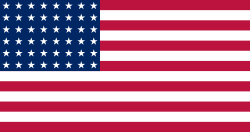USS Puritan (BM-1)
 USS Puritan (BM-1) | |
| Základní údaje | |
|---|---|
| Typ | monitor |
| Uživatelé | US Navy |
| Jméno podle | Puritáni |
| Zahájení stavby | květen 1876 |
| Spuštěna na vodu | 6. prosince 1882 |
| Uvedena do služby | 10. prosince 1896 |
| Osud | vyřazen |
| Předchůdce | třída Amphitrite |
| Takticko-technická data | |
| Výtlak | 6060 t[1] |
| Délka | 90,3 m |
| Šířka | 18,33 m |
| Ponor | 5,49 m |
| Pohon | 8 kotlů, 2 parní stroje 3700 ihp |
| Rychlost | 12,4 uzlu |
| Posádka | 200/270 |
| Pancíř | až 356mm boky 356mm barbety 203mm věže 254mm velitelská věž 51mm paluba |
| Výzbroj | 4× 305mm kanón (2×2) 6× 102mm kanón (6×1) 6× 57mm kanón (6×1) |
USS Puritan (BM-1) byl monitor amerického námořnictva. Ve službě byl v letech 1896–1910. Byl to největší monitor amerického námořnictva.[1]
Stavba

Monitor byl oficiálně přestavbou nedokončeného staršího plavidla stejného jména, odsouhlasenou roku 1886 a objednanou roku 1889. Ve skutečnosti však byly jen některé jeho části využity při stavbě nového monitoru. Postavila jej americká loděnice John Roach & Sons v Chesteru v Pensylvánii, přičemž dokončení proběhlo v loděnici New York Navy Yard v Brooklynu. Zahájení stavby proběhlo v květnu 1876, na vodu byla loď spuštěna 6. prosince 1882 a dne 10. prosince 1896 byla přijata do služby.[1]
Konstrukce

Jednalo se o velký monitor se silnou výzbrojí a pancéřováním. Trup byl vyroben z oceli, přičemž jeho boky chránil až 356mm pancíř. Hlavní výzbroj tvořily čtyři 305mm kanóny ve dvoudělových věžích na přídi a na zádi. Doplňovalo je ještě šest 102mm kanónů a šest 57mm kanónů. Pohonný systém tvořilo osm kotlů a dva parní stroje o výkonu 3700 ihp, pohánějící dva lodní šrouby. Nejvyšší rychlost dosahovala 12,4 uzlu.[1]
Operační nasazení
Za španělsko-americké války v roce 1898 byl monitor nasazen v Karibiku.[1] Od dubna 1898 se podílel na blokádě Kuby. V letech 1899–1902 byl využíván jako cvičná loď na Námořní akademii, v letech 1903–1904 jako plovoucí kasárna ve Filadelfii a následně do svého vyřazení roku 1909 opět při výcviku v rámci námořní milice. Dne 23. dubna 1910 byl vyřazen ze služby. Roku 1922 byl sešrotován.[2][3]
Odkazy
Reference
Literatura
- HYNEK, Vladimír; KLUČINA, Petr. Válečné lodě 2: Mezi krymskou a rusko-japonskou válkou. Praha: Naše vojsko, 1986.
Externí odkazy
 Obrázky, zvuky či videa k tématu USS Puritan (BM-1) na Wikimedia Commons
Obrázky, zvuky či videa k tématu USS Puritan (BM-1) na Wikimedia Commons
Média použitá na této stránce
US Flag with 48 stars. In use for 47 years from July 4, 1912, to July 3, 1959.
Autor: Internet Archive Book Images, Licence: No restrictions
Identifier: americaswarforhu00newy (find matches)
Title: America's war for humanity related in story and picture, embracing a complete history of Cuba's struggle for liberty, and the glorious heroism of America's soldiers and sailors
Year: 1898 (1890s)
Authors:
Subjects: Spanish-American War, 1898
Publisher: New York, St. Louis, N.D. Thompson Publishing Company
Contributing Library: The Library of Congress
Digitizing Sponsor: Sloan Foundation
View Book Page: Book Viewer
About This Book: Catalog Entry
View All Images: All Images From Book
Click here to view book online to see this illustration in context in a browseable online version of this book.
Text Appearing Before Image:
e. This low point gradually rises to a hillabout two hundred feet above the sea, one mile to the west of the extremity.The mouth of the harbor is about a half-mile in width, and the low easternshore makes a wide sweep around the coast to the inside. On the westernpoint is Punta Gorda. This new line of earthworks is located on a hill,behind which is an old stone fort. On the east side is a long fort of stoneand masonry flanked by earthworks, called Morillo Castle. This is all of thefortifications which were engaged with the American ships on the afternoonof April 26th. During the week previous to the attack the torpedo boatFoote was fired upon while scouting off this port. Captain Chadwickremarked, after the smoke had cleared away, We wished to discouragetheir work, and as an afterthought he added They fired on one of ourboats the other day. About eleven oclock on the morning of April 26th, MheNew York, whichhad lain almost motionless for several hours off the Havana blockading station
Text Appearing After Image:
THE FIRST BATTLE—MATANZAS LEARNS A LESSON. 283 wheeled slowly round and headed to the eastward. Word was passed alongthe decks that there might be something on beside a change of air. Withoutdefinite information descending from the powers that be, vague but con-vincing premonitions began to thrill the ships company on the surface. Thiswas simply a little cruise of inspection along the coast, and to meet theblockading division off Matanzas; but one would say softly to another: Ithink we are in for a little excitement; we may mix things up. At 12:30oclock, from the deck of the flagship, Matanzas Inlet showed, with the longpoint shielding it like a protecting arm. The Cincinnati, Captain Chesterin command, was about two miles off the harbor, and the Puritan, CaptainHarrington, was wallowing close by. When the New York came almost off the point, two miles distant, a longyellow streak showed the location of fresh earthworks, and around and onthis ridge a number of men were moving like bu
Note About Images
The USS Puritan (BM-1).
USS Puritan (BM-1), a monitor of the US Navy, c. 1898.



